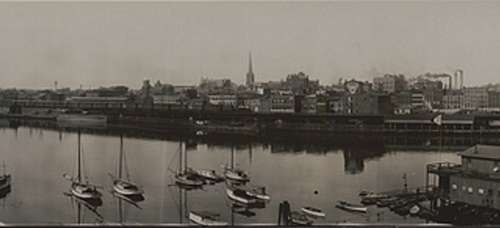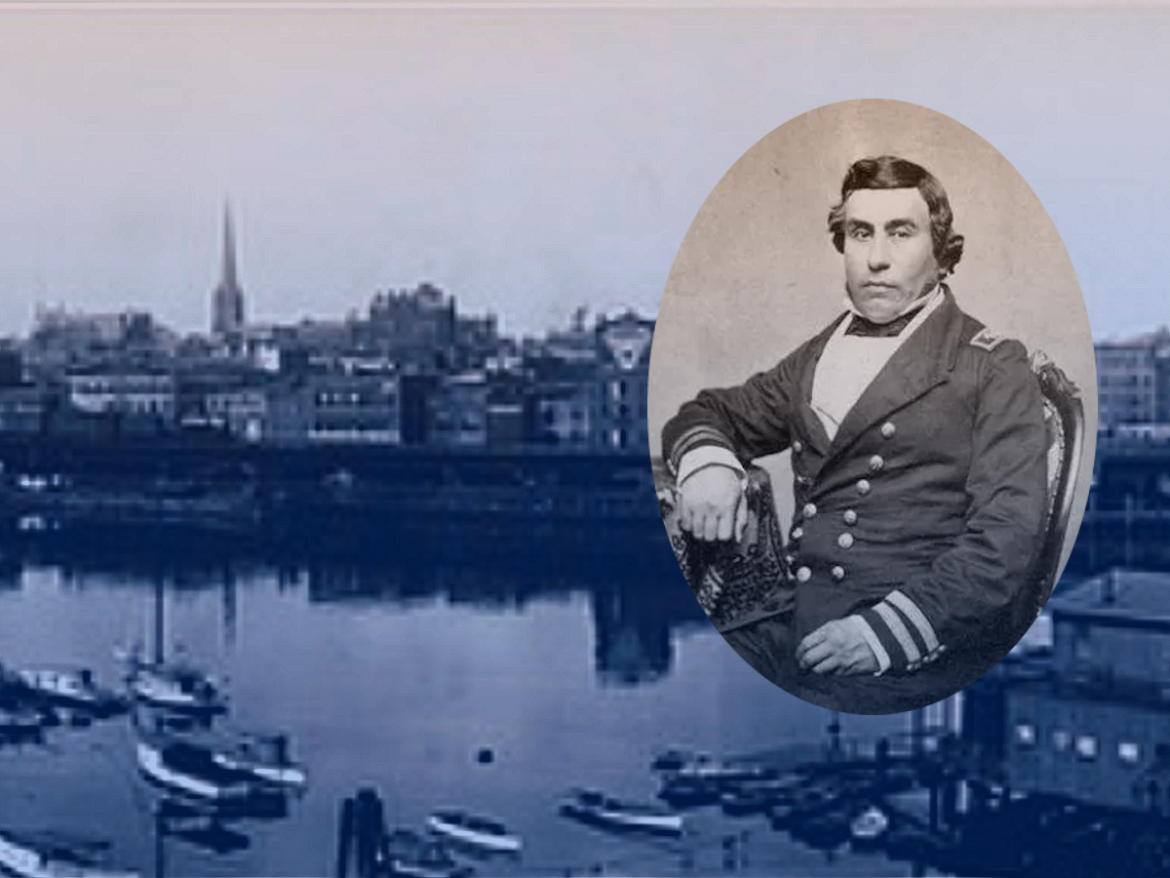The strange death of Civil War hero George Colvocoresses on a busy street in Bridgeport, Conn., reads like a Sherlock Holmes mystery – without a solution.
He was a retired U.S. Navy captain on a business trip to New York City from his home in Litchfield, Conn. He had acted strangely the previous week, and some of his actions couldn’t be explained. Just as his ferry was about to leave from a Bridgeport dock, witnesses heard a pistol shot and a policeman found Colvocoresses dying in the street.
There were so many strange aspects to his death that some thought he committed suicide. Others said it was impossible for a man of Colvocoresses’ state of mind and character to take his own life.

Capt. George Colvocoresses
George Colvocoresses
He was born Oct. 22, 1816 in Chios, Greece. During the Greek War of Independence, the Turks massacred the Chios islanders and sold six-year-old George Colvocoresses into slavery. His father ransomed him and sent him to the United States for an education. He was one of about 40 Greek orphans sent for adoption to the United States after the war.
Alden Partridge, who founded Norwich University in Vermont, adopted the boy. Colvocoresses graduated from the military school and earned an appointment as a midshipman after a year at the naval school at Norfolk.

USS Vincennes in Disappointment Bay, Antarctica, during the Wilkes Expedition.
He served on the Wilkes Expedition, a four-year exploration of the Pacific Ocean. Colvocoresses wrote a book about the expedition, a milestone in American science. He called it Four Years in a Government Exploring Expedition. Colvos Passage, a tidal strait in Puget Sound, was named in his honor.

Colvos Passage
As commander of the USS Supply during the Civil War, he captured a blockade runner bringing arms and munitions for the Confederates.
He also raided Georgia, once capturing 26 soldiers and destroying a bridge to cut off the Confederate cavalry. At the close of the war he served as a commander in the Pacific. When a Spanish fleet menaced Valparaiso, Chile, Colvocoresses took action to protect American citizens and their property.
His son, George Partridge Colvocoresse, served with him during the Civil War. He wrote,
One who knew him well never heard him complain. His modesty and reserve never led him to seek personal advancement. He was simple in his habits, just and most honorable in his dealings with all men and affectionate in his family relations.
Strange Murder?
Colvocoresses retired with the rank of captain in 1867 and moved to Litchfield with his second wife. On June 3, 1872, the 60-year-old veteran took a train to Bridgeport, where he planned to take an 11:00 p.m. steamer to New York and meet with his insurance agent.

Bridgeport waterfront, 1913. Courtesy Library of Congress.
He had an umbrella, $8,000 in cash inside a carpet bag and a cane with a sword in it. In addition, he may have had securities worth $80,000. He went to a hotel hoping to eat dinner, but the kitchen had closed and he went to a restaurant instead. Then he went back to the hotel to return a key he had mistakenly taken the previous week, stopped at a drug store to buy paper and envelopes and then headed toward the dock.
He never made it. He was found dying on busy Clinton Street.
His unbuttoned shirt was on fire where the bullet had entered his abdomen. And yet his coat and vest had no bullet hole. He had apparently fought off his attacker, for his cane lay in pieces and the sword had bent.
Police took his body to the station. They found his empty valise on a wharf, cut open. A horse pistol was found across the street, and the next day a bullet, powder horn and percussion caps were found 60 feet from his body. The bullet was wrapped in a handkerchief.
The Boston Globe reported on his strange behavior the week before. He had come to Bridgeport, wandered around the dock and, during dinner at a hotel, zealously protected a satchel that a clerk said was empty. Though he had an appointment in New York the next day, he hung around Bridgeport instead.
Suicide Theory
Some said he killed himself.
He had taken out eight life insurance policies worth $195,000 before his death. His insurance premiums would have cost him about $20,000 per year, and he was worth only about $40,000 or $50,000. And why else would his shirt be unbuttoned?
Others pointed out he had a good relationship with his family. He had a sterling character and would never commit suicide. How could he have thrown his gun across the street after he shot himself?
The suicide theory, though, did allow insurance companies to avoid paying out his policy.
Police incompetence didn’t help. Someone stole Colvocoresses’ pants when his body lay at the police station.
The murder of George Colvocoresses was never solved. A Danish sailor did claim on his deathbed he had murdered the captain in an attempted robbery gone bad.
The insurance companies eventually paid out 50 cents on the dollar.
His son and great-grandson graduated from Norwich and followed distinguished military careers. Colvocoresses’ great-grandson pioneered satellite mapping techniques. His great-great granddaughter also graduated from Norwich in 2005 and received a commission as a second lieutenant in the U.S. Army.
This story was updated in 2023.
Images: Colvos Passage By Memley6 – Own work, CC BY-SA 4.0, https://commons.wikimedia.org/w/index.php?curid=45557119. With thanks to Harold Colvocoresses, “Captain George Musalas Colvocoresses, U. S. N.” The Washington Historical Quarterly 25, no. 3 (1934): 163–70.

1 comment
[…] was read, the only bequests amounted to a few thousand dollars. This was well short of his reported $195,000 policy. The New York Times also took exception to this theory, stating that Colvocoresses was a man of high […]
Comments are closed.